第三人称指示语
- 格式:ppt
- 大小:32.50 KB
- 文档页数:8
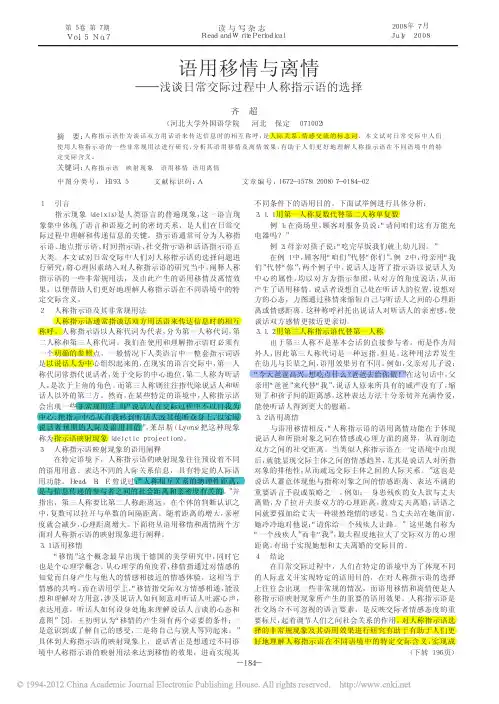
1引言指示现象(deixis)是人类语言的普遍现象,这一语言现象集中体现了语言和语境之间的密切关系,是人们在日常交际过程中理解和传递信息的关键。
指示语通常可分为人称指示语、地点指示语、时间指示语、社交指示语和话语指示语五大类。
本文试对日常交际中人们对人称指示语的选择问题进行研究,将心理因素纳入对人称指示语的研究当中,阐释人称指示语的一些非常规用法,及由此产生的语用移情及离情效果,以便帮助人们更好地理解人称指示语在不同语境中的特定交际含义。
2人称指示语及其非常规用法人称指示语通常指谈话双方用话语来传达信息时的相互称呼。
人称指示语以人称代词为代表,分为第一人称代词,第二人称和第三人称代词。
我们在使用和理解指示语时必须有一个明确的参照点,一般情况下人类语言中一整套指示词语是以说话人为中心组织起来的,在现实的语言交际中,第一人称代词常指代说话者,处于交际的中心地位,第二人称为听话人,是次于主角的角色。
而第三人称则往往指代除说话人和听话人以外的第三方。
然而,在某些特定的语境中,人称指示语会出现一些非常规用法,即“说话人在交际过程中不以自我为中心,把指示中心从自我转到听话人或其他听众身上,以实现说话者预期的人际及语用目的”,莱昂斯(Lyons)把这种现象称为指示语映射现象(deicticprojection)。
3人称指示语映射现象的语用阐释在特定语境下,人称指示语的映射现象往往预设着不同的语用用意、表达不同的人际关系信息,具有特定的人际语用功能。
Head,B.F.曾说过:“人称相互关系的物理性距离,是与信息传递的参与者之间的社会距离和亲密度有关的。
”并指出,第三人称要比第二人称距离远,在个体的判断认识之中,复数可以拉开与单数的间隔距离。
随着距离的增大,亲密度就会减少,心理距离增大。
下面将从语用移情和离情两个方面对人称指示语的映射现象进行阐释。
3.1语用移情“移情”这个概念最早出现于德国的美学研究中,同时它也是个心理学概念。
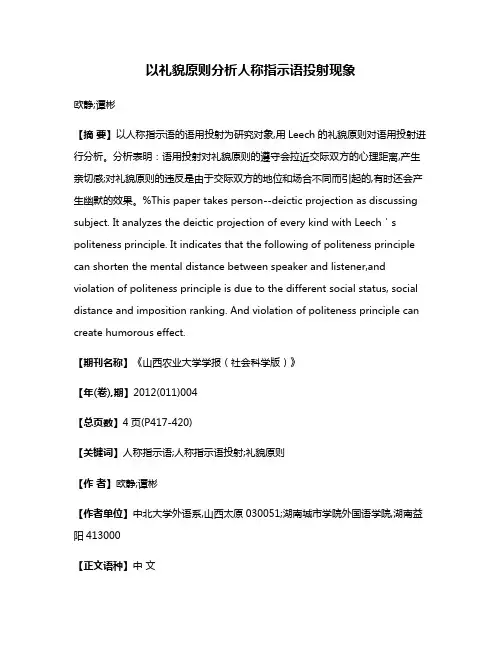
以礼貌原则分析人称指示语投射现象欧静;谭彬【摘要】以人称指示语的语用投射为研究对象,用Leech的礼貌原则对语用投射进行分析。
分析表明:语用投射对礼貌原则的遵守会拉近交际双方的心理距离,产生亲切感;对礼貌原则的违反是由于交际双方的地位和场合不同而引起的,有时还会产生幽默的效果。
%This paper takes person--deictic projection as discussing subject. It analyzes the deictic projection of every kind with Leech's politeness principle. It indicates that the following of politeness principle can shorten the mental distance between speaker and listener,and violation of politeness principle is due to the different social status, social distance and imposition ranking. And violation of politeness principle can create humorous effect.【期刊名称】《山西农业大学学报(社会科学版)》【年(卷),期】2012(011)004【总页数】4页(P417-420)【关键词】人称指示语;人称指示语投射;礼貌原则【作者】欧静;谭彬【作者单位】中北大学外语系,山西太原030051;湖南城市学院外国语学院,湖南益阳413000【正文语种】中文【中图分类】H030指示语(deixis)源于希腊语,指示语就是表达指示信息的词语。
它是语用学研究的一个重要组成部分,主要研究如何运用语言形式来表示语境特征以及如何依靠语境来分析理解话语,它是语言和语境之间关系最明显、最直接的语言反映。
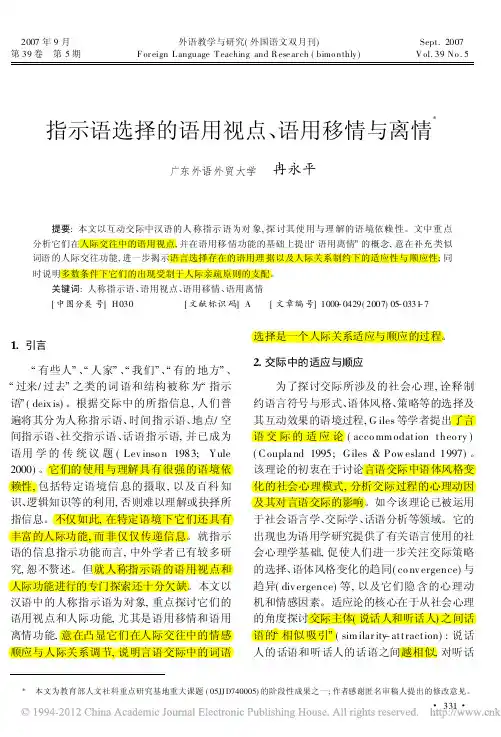
2007年9月第39卷第5期外语教学与研究(外国语文双月刊)F or eign L anguage T eaching and R ese ar ch(bimo nthly)Sept.2007V ol.39N o.5指示语选择的语用视点、语用移情与离情*广东外语外贸大学冉永平提要:本文以互动交际中汉语的人称指示语为对象,探讨其使用与理解的语境依赖性。
文中重点分析它们在人际交往中的语用视点,并在语用移情功能的基础上提出/语用离情0的概念,意在补充类似词语的人际交往功能,进一步揭示语言选择存在的语用理据以及人际关系制约下的适应性与顺应性;同时说明多数条件下它们的出现受制于人际亲疏原则的支配。
关键词:人称指示语、语用视点、语用移情、语用离情[中图分类号]H030[文献标识码]A[文章编号]1000-0429(2007)05-0331-71.引言/有些人0、/人家0、/我们0、/有的地方0、/过来/过去0之类的词语和结构被称为/指示语0(deix is)。
根据交际中的所指信息,人们普遍将其分为人称指示语、时间指示语、地点/空间指示语、社交指示语、话语指示语,并已成为语用学的传统议题(Lev inso n1983;Yule 2000)。
它们的使用与理解具有很强的语境依赖性,包括特定语境信息的摄取,以及百科知识、逻辑知识等的利用,否则难以理解或抉择所指信息。
不仅如此,在特定语境下它们还具有丰富的人际功能,而非仅仅传递信息。
就指示语的信息指示功能而言,中外学者已有较多研究,恕不赘述。
但就人称指示语的语用视点和人际功能进行的专门探索还十分欠缺。
本文以汉语中的人称指示语为对象,重点探讨它们的语用视点和人际功能,尤其是语用移情和语用离情功能,意在凸显它们在人际交往中的情感顺应与人际关系调节,说明言语交际中的词语选择是一个人际关系适应与顺应的过程。
2.交际中的适应与顺应为了探讨交际所涉及的社会心理,诠释制约语言符号与形式、语体风格、策略等的选择及其互动效果的语境过程,G iles等学者提出了言语交际的适应论(acco mm odation theo ry) (C oupla nd1995;Giles&Pow esland1997)。
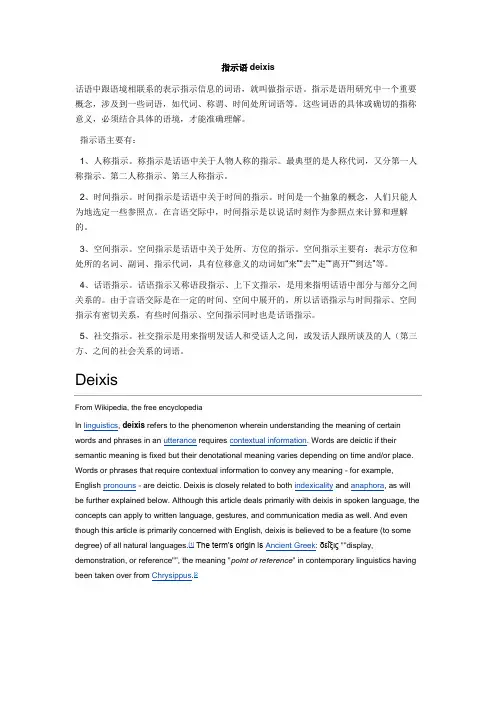
指示语deixis话语中跟语境相联系的表示指示信息的词语,就叫做指示语。
指示是语用研究中一个重要概念,涉及到一些词语,如代词、称谓、时间处所词语等。
这些词语的具体或确切的指称意义,必须结合具体的语境,才能准确理解。
指示语主要有:1、人称指示。
称指示是话语中关于人物人称的指示。
最典型的是人称代词,又分第一人称指示、第二人称指示、第三人称指示。
2、时间指示。
时间指示是话语中关于时间的指示。
时间是一个抽象的概念,人们只能人为地选定一些参照点。
在言语交际中,时间指示是以说话时刻作为参照点来计算和理解的。
3、空间指示。
空间指示是话语中关于处所、方位的指示。
空间指示主要有:表示方位和处所的名词、副词、指示代词,具有位移意义的动词如“来”“去”“走”“离开”“到达”等。
4、话语指示。
话语指示又称语段指示、上下文指示,是用来指明话语中部分与部分之间关系的。
由于言语交际是在一定的时间、空间中展开的,所以话语指示与时间指示、空间指示有密切关系,有些时间指示、空间指示同时也是话语指示。
5、社交指示。
社交指示是用来指明发话人和受话人之间,或发话人跟所谈及的人(第三方、之间的社会关系的词语。
DeixisFrom Wikipedia, the free encyclopediaIn linguistics, deixis refers to the phenomenon wherein understanding the meaning of certain words and phrases in an utterance requires contextual information. Words are deictic if their semantic meaning is fixed but their denotational meaning varies depending on time and/or place. Words or phrases that require contextual information to convey any meaning - for example, English pronouns - are deictic. Deixis is closely related to both indexicality and anaphora, as will be further explained below. Although this article deals primarily with deixis in spoken language, the concepts can apply to written language, gestures, and communication media as well. And even though this article is primarily concerned with English, deixis is believed to be a feature (to some degree) of all natural languages.[1]The term’s origin is Ancient Greek: δεῖξις ""display, demonstration, or reference"", the meaning "point of reference" in contemporary linguistics having been taken over from Chrysippus.[2Types of deixis[edit]Traditional categoriesPossibly the most common categories of contextual information referred to by deixis are those of person, place, and time - what Fillmore calls the “major grammaticalized types” of deixis.[3] [edit]PersonPerson deixis concerns itself with the grammatical persons involved in an utterance, (1) those directly involved (e.g. the speaker, the addressee), (2) those not directly involved (e.g. overhearers—those who hear the utterance but who are not being directly addressed), and (3) those mentioned in the utterance.[4] In English, the distinctions are generally indicated by pronouns. The following examples show how. (The person deictic terms are in italics [a signaling notation that will continue through this article].)I am going to the movies.Would you like to have dinner?They tried to hurt me, but he came to the rescue.GenderIn many languages, that only have male and female, referring to gender neutral subjects has different aspects. Objects , or things have their own gender too between male or female. When referring to a genderless object, it is often referred to as a male, though the object is genderless. In the English language, when referring to any character that has no gender, a self-aware entity, it is referred to a male, or as a "He", such as an "it" is inappropriate when calling the sentient object a thing. In many languages, they would address to people as in male, such as a group mixed with men and women is referred to as a male, such as Ils in French. An example would be :A man is responsible for his own soulas opposed toEach person is responsible for his or her own soulcommon in many religious text referring to people of all genders using only the male gender. This can be understood in context, the male gender being used to signify male or female persons.PlacePlace deixis, also known as space deixis, concerns itself with the spatial locations relevant to an utterance. Similarly to person deixis, the locations may be either those of the speaker and addressee or those of persons or objects being referred to. The most salient English examples are the adverbs“here” and “there”and the demonstratives“this” and “that” - although those are far from being the only deictic words.[3]Some examples:I enjoy living in this city.Here is where we will place the statue.She was sitting over there.Unless otherwise specified, place deictic terms are generally understood to be relative to the location of the speaker, as inThe shop is across the street.where “across the street” is understood to mean “across the street from where I am right now.”[3] It is interesting to note that while “here” and “there” are often used to refer to locations near to and far from the speaker, respectively, “there” can also refer to the location of the addressee, if they are not in the same location as the speaker. So, whileHere is a good spot; it is too sunny over there.exemplifies the former usage,How is the weather there?is an example of the latter.[4]Languages usually show at least a two-way referential distinction in their deictic system: proximal, i.e. near or closer to the speaker, and distal, i.e. far from the speaker and/or closerto the addressee. English exemplifies this with such pairs as this and that, here and there, etc. In other languages, the distinction is three-way: proximal, i.e. near the speaker, medial, i.e. near the addressee, and distal, i.e. far from both. This is the case in a few Romance languages and in Korean, Japanese, Thai, Filipino and Turkish The archaic Englishforms yon and yonder (still preserved in some regional dialects) once represented a distal category which has now been subsumed by the formerly medial "there".[5]TimeTime, or temporal, deixis concerns itself with the various times involved in and referred to inan utterance. This includes time adverbs like "now", "then", "soon", and so forth, and also different tenses. A good example is the word tomorrow, which denotes the consecutive next day after every day. The "tomorrow" of a day last year was a different day than the "tomorrow" of a day next week. Time adverbs can be relative to the time when an utterance is made (what Fillmore calls the "encoding time", or ET) or when the utterance is heard (Fillmore’s "decoding time", or DT).[3] While these are frequently the same time, they can differ, as in the case of prerecorded broadcasts or correspondence. For example, if one were to writeIt is raining out now, but I hope when you read this it will be sunny.the ET and DT would be different, with the former deictic term concerning ET and the latterthe DT.Tenses are generally separated into absolute (deictic) and relative tenses. So, forexample, simple English past tense is absolute, such as inHe went.while the pluperfect is relative to some other deictically specified time, as inHe had gone.Other categoriesThough the traditional categories of deixis are perhaps the most obvious, there are other types of deixis that are similarly pervasive in language use. These categories of deixis were first discussed by Fillmore and Lyons.[4][edit]DiscourseDiscourse deixis, also referred to as text deixis, refers to the use of expressions within an utterance to refer to parts of the discourse that contains the utterance — including the utterance itself. For example, inThis is a great story.“this” refers to an upcoming portion of the discourse, and inThat was an amazing day.that” refers to a prior portion of the discourse.Distinction must be made between discourse deixis and anaphora, which is when an expression makes reference to the same referent as a prior term, as inMatthew is an incredible athlete; he came in first in the race.Lyons points out that it is possible for an expression to be both deictic and anaphoric at the same time. In his exampleI was born in London and I have lived here/there all my life.“here” or “there” function anaphorically in their refe rence to London, and deictically in that the choice between “here” or “there” indicates whether the speaker is or is not currently in London.[1]The rule of thumb to distinguish the two phenomenon is as follows: when an expression refers to another linguistic expression or a piece of discourse, it is discourse deictic. When that expression refers to the same item as a prior linguistic expression, it is anaphoric.[4]Switch reference is a type of discourse deixis, and a grammatical feature found in some languages, which indicates whether the argument of one clause is the same as the argument of the previous clause. In some languages, this is done through same subject markers and different subject markers. In the translated example "John punched Tom, and left-[samesubject marker]," it is John who left, and in "John punched Tom, and left-[different subject marker]," it is Tom who left.[citation needed][edit]SocialSocial deixis concerns the social information that is encoded within various expressions, such as relative social status and familiarity. Two major forms of it are the so-called T-V distinctions and honorifics.Usages of deixisIt is helpful to distinguish between two usages of deixis, gestural and symbolic, as well asnon-deictic usages of frequently deictic words. Gestural deixis refers, broadly, to deictic expressions whose understanding requires some sort of audio-visual information. A simple example is when an object is pointed at and referred to as “this” or “that”. However, the category can include other types of information than pointing, such as direction of gaze, tone of voice, and so on. Symbolic usage, by contrast, requires generally only basic spatio-temporal knowledge of the utterance.[4] So, for exampleI broke this finger.requires being able to see which finger is being held up, whereasI love this city.requires only knowledge of the current location. In a similar vein,I went to this city one time . . .is a non-deictic usage of "this", which does not reference anything specific.Rather, it is used as an indefinite article, much the way "a" could be used inits place.。

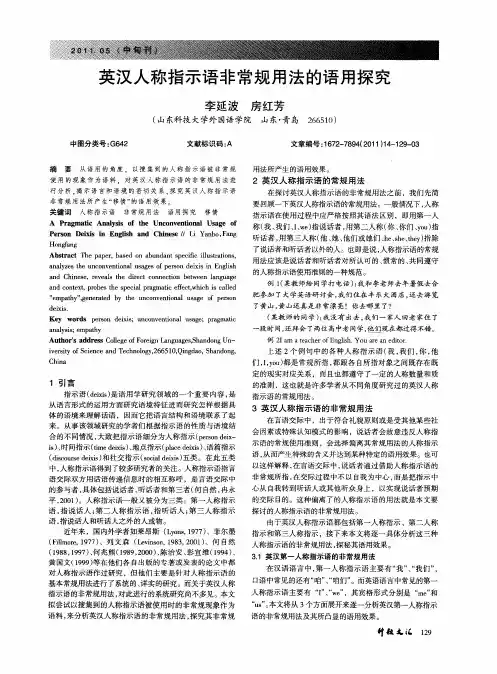
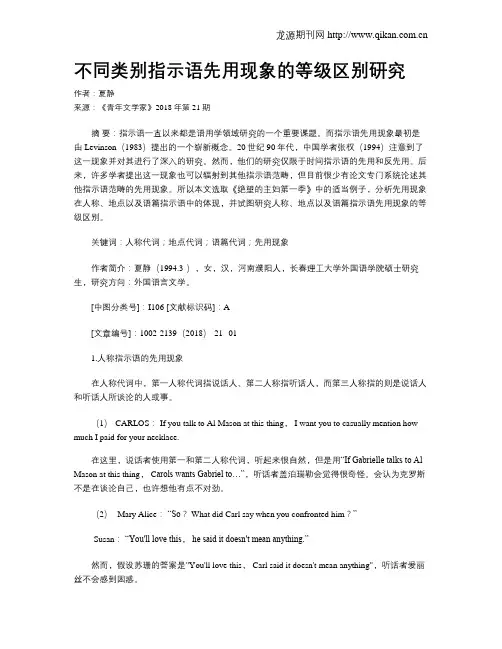
不同类别指示语先用现象的等级区别研究作者:夏静来源:《青年文学家》2018年第21期摘要:指示语一直以来都是语用学领域研究的一个重要课题。
而指示语先用现象最初是由Levinson(1983)提出的一个崭新概念。
20世纪90年代,中国学者张权(1994)注意到了这一现象并对其进行了深入的研究。
然而,他们的研究仅限于时间指示语的先用和反先用。
后来,许多学者提出这一现象也可以辐射到其他指示语范畴,但目前很少有论文专门系统论述其他指示语范畴的先用现象。
所以本文选取《绝望的主妇第一季》中的适当例子,分析先用现象在人称、地点以及语篇指示语中的体现,并试图研究人称、地点以及语篇指示语先用现象的等级区别。
关键词:人称代词;地点代词;语篇代词;先用现象作者简介:夏静(1994.3-),女,汉,河南濮阳人,长春理工大学外国语学院硕士研究生,研究方向:外国语言文学。
[中图分类号]:I106 [文献标识码]:A[文章编号]:1002-2139(2018)-21--011.人称指示语的先用现象在人称代词中,第一人称代词指说话人、第二人称指听话人,而第三人称指的则是说话人和听话人所谈论的人或事。
(1)-CARLOS: If you talk to Al Mason at this thing, I want you to casually mention how much I paid for your necklace.在这里,说话者使用第一和第二人称代词,听起来很自然,但是用“If Gabrielle talks to Al Mason at this thing, C arols wants Gabriel to…”,听话者盖泊瑞勒会觉得很奇怪。
会认为克罗斯不是在谈论自己,也许想他有点不对劲。
(2) -Mary Alice:“So? What did Carl say when you confronted him?”-Susan:“You'll love this,he said it doesn't mean anything.”然而,假设苏珊的答案是"You'll love this, Carl said it doesn't mean anything",听话者爱丽丝不会感到困惑。
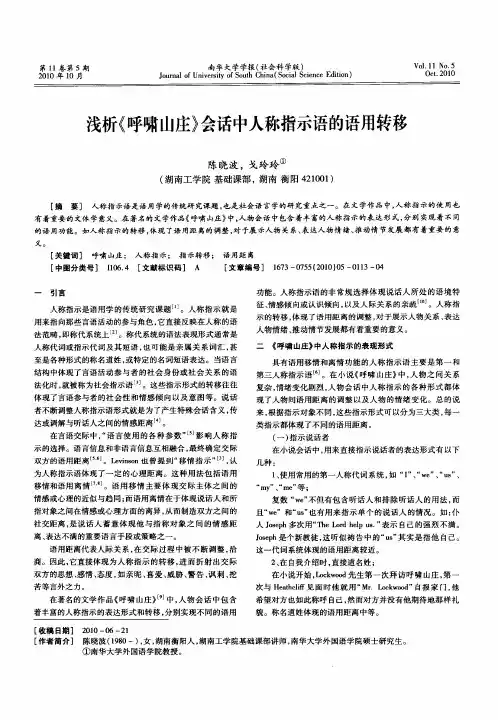
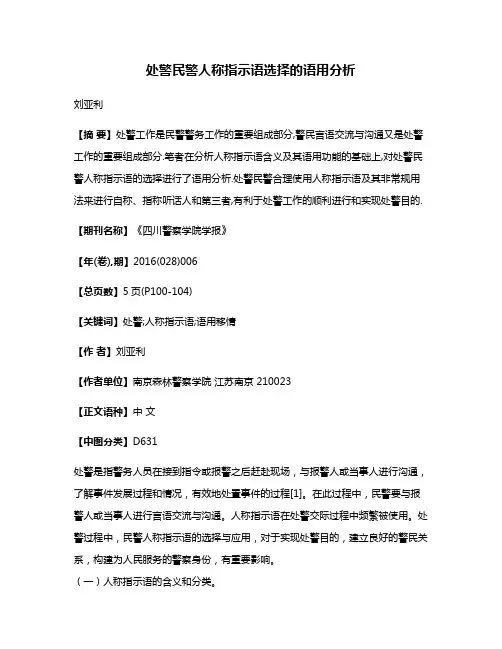
处警民警人称指示语选择的语用分析刘亚利【摘要】处警工作是民警警务工作的重要组成部分,警民言语交流与沟通又是处警工作的重要组成部分.笔者在分析人称指示语含义及其语用功能的基础上,对处警民警人称指示语的选择进行了语用分析.处警民警合理使用人称指示语及其非常规用法来进行自称、指称听话人和第三者,有利于处警工作的顺利进行和实现处警目的.【期刊名称】《四川警察学院学报》【年(卷),期】2016(028)006【总页数】5页(P100-104)【关键词】处警;人称指示语;语用移情【作者】刘亚利【作者单位】南京森林警察学院江苏南京 210023【正文语种】中文【中图分类】D631处警是指警务人员在接到指令或报警之后赶赴现场,与报警人或当事人进行沟通,了解事件发展过程和情况,有效地处置事件的过程[1]。
在此过程中,民警要与报警人或当事人进行言语交流与沟通。
人称指示语在处警交际过程中频繁被使用。
处警过程中,民警人称指示语的选择与应用,对于实现处警目的,建立良好的警民关系,构建为人民服务的警察身份,有重要影响。
(一)人称指示语的含义和分类。
人称指示语就是言语交际中用以表示说话人、听话人或第三者的词语或结构[2]。
大多数语言中的人称指示语都可分为三类,有单数和复数形式之别。
第一人称指示语,包括说话人(自称),例如汉语中的第一人称指示语“我”、“我们”,“咱”、“咱们”,英语中的I(me),we(us);也可能包括听话人,例如“我们”、“咱们”等;第二人称指示语包括听话人(对称),如汉语中的“你”、“你们”,英语中的you;第三人称指示语既不包括说话人也不包括听话人(他称),例如汉语中第三人称指示语“他”、“她”、“他们”、“它们”、“那人”、“这些人”、“有人”等,英语中第三人称指示语he/him,she/her,they/them,those people,that person,somebody等,多指说话人和听话人以外的第三者[2]。
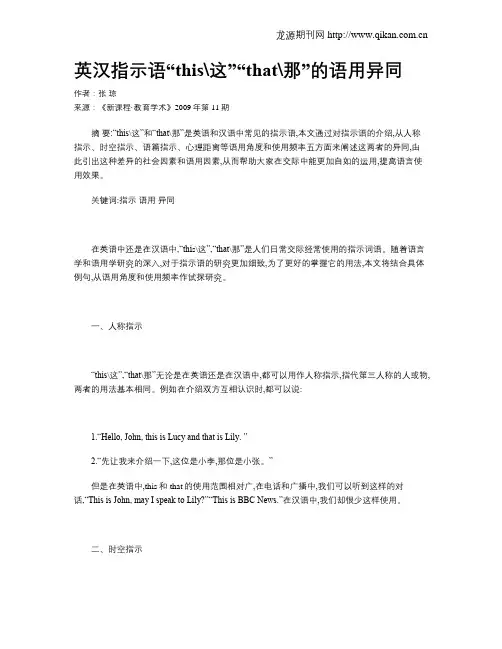
英汉指示语“this\这”“that\那”的语用异同作者:张琼来源:《新课程·教育学术》2009年第11期摘要:“this\这”和“that\那”是英语和汉语中常见的指示语,本文通过对指示语的介绍,从人称指示、时空指示、语篇指示、心理距离等语用角度和使用频率五方面来阐述这两者的异同,由此引出这种差异的社会因素和语用因素,从而帮助大家在交际中能更加自如的运用,提高语言使用效果。
关键词:指示语用异同在英语中还是在汉语中,“thi s\这”,“that\那”是人们日常交际经常使用的指示词语。
随着语言学和语用学研究的深入,对于指示语的研究更加细致,为了更好的掌握它的用法,本文将结合具体例句,从语用角度和使用频率作试探研究。
一、人称指示“this\这”,“that\那”无论是在英语还是在汉语中,都可以用作人称指示,指代第三人称的人或物,两者的用法基本相同。
例如在介绍双方互相认识时,都可以说:1.“Hello, John, this is Lucy and that is Lily. ”2.“先让我来介绍一下,这位是小李,那位是小张。
”但是在英语中,this和that的使用范围相对广,在电话和广播中,我们可以听到这样的对话,“This is John, may I speak to Lily?”“This is BBC News.”在汉语中,我们却很少这样使用。
二、时空指示指示词表示的另一种距离概念是时空上的远近。
在指称空间距离时,汉语和英语的用法基本相同。
英语中有过去时和现在时,通过不同的语法就可以把时间表达出来,而在汉语中却没有时态的制约,所以在使用指示词时用法就相对复杂。
“this\这”可指刚刚过去、现在或不远的将来发生的事情,如1.After saying this, he left the classroom.(过去)2. We believe that this investment will be helpful for us to hold the Olympic Game. (将来)“that\那”多用来指称过去发生的事情和具有消极感情的事物。
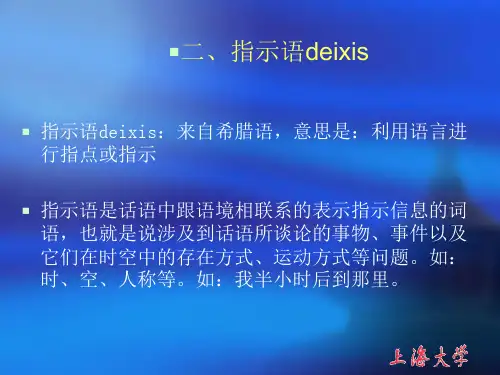
第9卷第6期2012年6月Journal of Hubei University of Economics(Humanities and Social Sciences)湖北经济学院学报(人文社会科学版)Jun.2012Vol.9No.61.前言指示现象是语用学研究的基本课题之一。
在语用学中,指示语(deixis )是说话人通过语言结构营造语境产生“言外之意的”达到言语交际目的的重要方式和手段。
也就是说,选择和利用适宜的指示词语是说话人间接达到交际目的的一种重要的语用策略(刘森林,2006)。
Levinson 将指示分为人称指示、时间指示、地点指示、话语指示和社交指示五类。
人称指示语是指对编码于言语活动中的参与者或相关角色的符号指称。
人称指示语包括人称代词和身份语(何自然,1997)。
人称指示代词包括第一人称,第二人称和第三人称;身份语是指用以表示人物身份的代名词,包括敬语、谦词、亲属称谓、表示社会地位、家庭地位的名词短语等。
与人际关系关联密切的身份、地位、权势等客观因素和情感、态度、动机等主观因素对演讲中人称指示语的使用起着制约作用。
语用距离是指交际双方在特定的交际环境中所感知和确认的彼此间的关系密切程度。
语用距离可分为初始语用距离和交际语用距离。
初始语用距离指交际行为发生之前,双方所推断的彼此间的语用亲密度;交际语用距离即是交际双方根据对方的话语所推定的语用距离。
对特定的交际双方而言,初始语用距离是静止的或相对静止的,而交际语用距离是不断变化的(杨春红,2005)。
这种现象反映在演讲词的人称指示语的选择上犹为明显。
演讲者在特定的语境中,通过人称指示语的选择、转换等语用策略维持或者改变现有的语用距离,并透过人称指示语的选用凸现思想、感情等言外之力,实现情感互动,有效达到演讲的预期目的。
2.演讲词中人称指示语的语用策略实施人称指示语语用策略的含义有两层:一是选择在特定语境中选择适宜的指示语语言形式达到交际目的;二是在第一、第二或者第三人称指示代词之间进行转换达到交际目的(刘森林,2006)。
《年轮》中人称指示语和心理距离的分析作者:戴仲平张伟英来源:《现代交际》2012年第01期[摘要]人称指示语是语用学一个重要的研究内容。
通过人称指示语的变化,可以拉近或拉开人们之间的心理距离。
同时,心理距离也会影响人称指示语的使用。
本文主要分析了小说《年轮》中人称指示语和心理距离的关系。
[关键词]人称指示语心理距离[中图分类号]H09 [文献标识码]A [文章编号]1009-5349(2012)01-0065-02指示语是用作指示的语言单位,通常被表述为意义具有相对性和不确定性,只有在语境中才能够被充分理解的语言表达式。
人称指示语是指示语的一种,指谈话双方传达信息时的相互称呼,即通过公开或隐含的人称代词把话语中涉及的人或物与说话者、听话者或第三者联系起来,表明彼此间的关系。
它是以发话人作基准的,受话人理解话语是自然要对人称指示做相应的变换。
人称指示语可分三类:第一人称指示,包括说话人;第二人称指示,包括听话人;第三人称指示,既不包括说话人,也不包括听话人,因此,在言语活动中,它一般不是谈话的参加者,但是在特定场合会用来借指说话人或听话人。
言语交际中说话人可以利用人称指示语来表达自己与交际对象或话语指称世界之间的距离,这就是心理距离。
心理距离具有不稳定性,有时语用距离小于实际空间距离,有时心理距离则大于实际空间距离。
同时,心理距离可以影响某些语境中人称指示的用法,暗含在话语中的谦虚、关心、友好、亲密、尊敬等善意情感和讽刺、指责等恶意情感都可以通过某些人称指示的特殊用法表现出来。
梁晓声的小说《年轮》,写的是北京知青之间的故事。
他在这本小说中就很善于通过人称指示语的变化,来反映人物之间的语用距离,从而刻画人物的心理。
一、心理距离小于实际距离对人称指示语的影响言语交际过程中,有时说话人会有意拉近与听话人的距离,使心理距离小于实际距离。
这种情况下,说话人主要是想表达谦虚、关心、友好、亲密等善意情感,从而影响人称指示在言语交际中的应用。
收稿日期:2003-06-23作者简介:邓小玲(1975) ),女,湖南邵阳人,湛江师范学院外国语学院讲师,硕士,从事应用语言学研究。
2004年8月第25卷第4期湛江师范学院学报JO URN AL OF Z HA NJI ANG NOR M AL CO LL EG EAug 1,2004Vol 125 N o 14汉英指示词/这0和/this 0的语用异同邓 小 玲(湛江师范学院外国语学院,广东湛江524048)摘 要:指示词是语用学中一个比较重要的概念,话语中的信息指示是理解和表达意思的关键。
汉英指示词/这0和/this 0不仅具有一定的共性,而且各有其特性,它们之间是不完全对等的。
关键词:/这0;/this 0;语用异同中图分类号:H313 文献标识码:A 文章编号:1006-4702(2004)04-0098-03不论是汉语还是英语都有一部分指示词,它们的意义会随着语境的改变而改变。
汉英指示词/这0和/this 0就是这样的指示词,在很多情况下它们可以通用,因为无论从意义还是语用上讲,它们都有许多共同点,所以人们习惯上把/this 0与/这0等同起来。
但实际上二者在一些语境中又有一些差别。
正确理解和运用这些指示词是语言交际中的重要环节,否则很容易产生语用失误。
这里笔者从语用学的角度比较和分析汉英指示词/这0和/this 0的语用异同。
(一)指示词/这0和/thi s 0的共性1、都可用作人称指示语,指示第三人称人称指示语是指谈话双方用话语传达信息时的相互称呼。
/this 0用于人称指示语时可指代第三人称,即除说话人与听话人以外的人。
它常常被用于初次见面时引见人的介绍语中,例如:/Hello,Jim.This is my si ster ,K ate.0/Nice to meet y ou,Kate.0在汉语中,指示词/这0也与/this 0一样,都可用来指代第三人称。
例如:/这是谁呀?我怎么以前从没见过?0/这是我的远房表哥。
指示的语用基础[摘要] 本文从人称指示,空间指示和时间指示等三个方面,从语用学的角度探讨了指示现象所产生的心理基础即心理距离。
[关键词] 人称指示空间指示时间指示心理距离心理距离的概念最早是由贝克尔曼提出的,之后约翰松和瓦尔内又推广了这一概念。
指示(deixis)的语用基础是心理距离,是对说话者心理状态和活动的反映。
这种心理状态和活动包括说话人与听话人间的社会关系和亲近程度,说话人对所说事物的态度以及说话人在处理语言时注入的正式程度。
本文从人称指示,空间指示和时间指示三方面来探讨指示的心理基础即心理距离。
一、人称指示和心理距离人称指示可分三类:第一人称指示,包括处于交际中心地位的说话人;第二人称指示,包括处于交际次要地位的听话人;第三人称指示,指交际双方之外的任意一个人。
在特定的情况下,说话者因交际目的的需要,对人称指示词的特定选择表明了说话人对听话人的态度、情感和相互关系。
1.用第一人称复数形式代替第一人称单数形式来说明说话者的情况。
这一用法常见于说话人谈及自己的成就,谦虚地将功劳归于自己所属的群体;如:(1)we have been observing the phenomenon for years, but at this stage we are still unable to be very specific about its nature or its cause.或将自己归于听话人之列以增加语言的亲和力。
(2)we are happy that you have come to visit us.2.用第一人称复数代替第二人称来指听话人,旨在通过降低自己的身份以加强语言的亲切感。
(3)how are we feeling today?此句中的说话者若是一位护士,那么则表明她正在询问患者的病情。
这种特定的选择we有拉近医护人员与患者关系的语用效果。
3.使用第三人称指示第二人称,使可能的责备显得间接和婉转,有时还能产生幽默和活跃气氛的效果,如(4)。